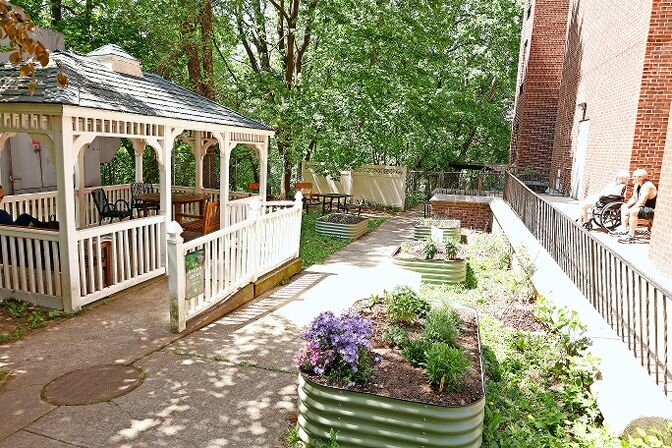Garden provides interaction for toddlers, seniors
It isn’t only asphalt and concrete jungles in New York City.
Members of the Schervier Community Garden recently opened a five-sensory garden to provide an interactive learning space for toddlers and a therapeutic healing space for wheelchair-bound nursing-home residents. It features a variety of herbs, vegetables and fruits, plants that smell like curry and Oreos, and textures that are soft like fur and prickly like a cactus.
The garden was built March 26 and holds eight raised gardening beds, soil and two seating areas donated by GrowNYC. The plants themselves were provided by a grant from The City Gardens Club of New York City, as well as members of the community garden.
Luane Kohnke, the head of the community garden’s steering committee, said the inspiration to build the sensory garden came from frequent visits from residents at Schervier Rehabilitation and Nursing Center, which is on the same property, and Renanim at Riverdale Preschool & Summer Camp.
“We’ve been letting them sniff, touch under supervision,” Kohnke said of the toddlers. “I would say the nursery school kids come probably three or four times a week. They like to touch things. Their teachers usually point out ‘don’t pull the leaves off.’”
The community garden also partners with McSweeney High School and Ellis Preparatory Academy. Each week, three McSweeney special-needs students help in the garden by weeding, composting and watering. Interns from the academy’s inter-generational gardening program have also helped with composting on Tuesday afternoons.
Students from both schools are credited with helping to build the garden beds and continuing to maintain them.
Stuart Katz, a cardiologist at New York University who helped put the garden together, said it’s a way to connect with the community, and joining the project was a way for him to get away from city life.
“We see the residents here and also the children,” Katz said. “When we were building it, the children were just so curious. I was putting dirt in there and soil and it was funny. ‘What are you doing, what’s that going to be?’ ‘We’re going to plant beautiful flowers you’re going to see this summer.’ They were so excited.”
Nava Simon, a gardener at the space, helped put some of the components of the beds together and put different layers of soil inside.
“The whole five senses come alive (in the garden),” Simon said. “A lot of kids are in front of devices. I mean they’re young, but they’re really out of touch with nature and their senses. It’s really terrible.”
That is what the garden hopes to combat. Wilma Rosen, a gardener at the space for 15 years, said one of her favorite parts of the gardening experience is getting dirt on her fingers.
“I’m one of the few gardeners that doesn’t use gloves,” Rosen said. We’re supposed to get your hands dirty. (Mine) are like permanently dirty, but I love it.”
Many of Rosen’s plants at the garden began life at her apartment with a grow light. She said she has been gardening for decades, and had a vegetable garden in her front yard when she lived in Massachusetts.
“You just put seeds in and you know what? Things pop up,” Rosen said. “It’s amazing to me and I don’t really want to know how it happens. I don’t want to read about that. I just want to be amazed on my thousand seedlings.”
Each plant is labeled at the garden, making it easy to identify and learn. Some of those plants include hens and chicks, field thistles, bachelor buttons, lemon drops, Audrey’s love and dwarf tomatoes. The gardeners considered separating plants into sense categories, but decided not to since all of the plants were edible and had other overlap in the senses they stimulate.
Several plants and herbs have been fortified with nettings to guard from rabbits, rats and groundhogs looking for a meal. But do they really help?
“My belief is that if, in your apartment, you have two locks and I have one lock, the burglar’s going to go for me first because it’s easier,” Kohnke said. “So I believe the rabbits are like that so if you don’t protect your plants they’re going to eat them. And if it’s complicated and they have to dig underneath or go over the top they’ll probably leave it alone.”
Kohnke, former head of analytics and accountability at a digital agency, has been at the community garden for six years.
As for the garden itself, it has been around since 2005, created by a Bon Secours Health System Healthy Communities Grant. Kohnke is one of five members who serve on the steering committee, which helps manage budget priorities of the garden and enforce bylaws.
Riverdale Senior Services also provides a garden coordinator and is used as a fiscal sponsor for grants and budget management.
At the community garden, 40 gardeners work at 42 5 foot by 10 foot garden spaces and 1,200 square feet of common garden areas and fruit trees. Each gardener’s space is decorated and characterized differently, some ornate with colorful rocks or huts.
“It’s the sense of accomplishment and excitement watching seeds turn into green luscious things to eat, and it’s healthy,” Simon said. “It’s a community. We do a lot of activities together. We learn from each other.”
Active gardeners include an 85-year-old man who crawls up on the greenhouse’s roof for repairs and one man who recently retrieved some tomatoes from Amish country in Pennsylvania. The garden also includes first generation Cuban, Korean, Russian, Dominican and Chinese immigrants, as well as second and third generation Hispanic, Caucasian and African-Americans.
“I think gardeners have this implicit hope,” Kohnke said. “It’s like you plan something, you don’t know what’s going to happen, so it’s all about hope for the future.”









